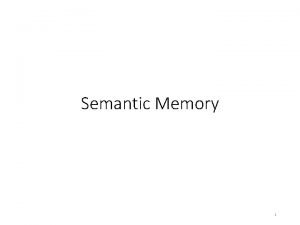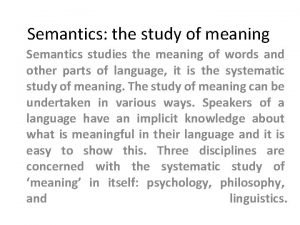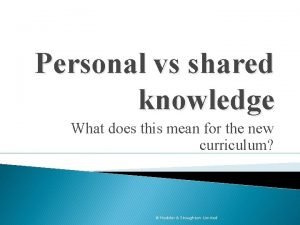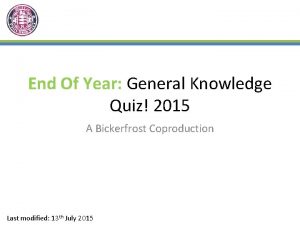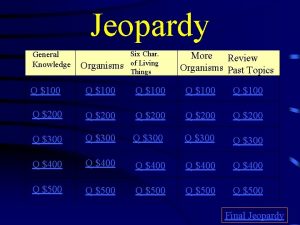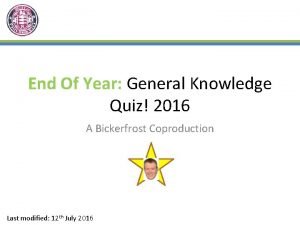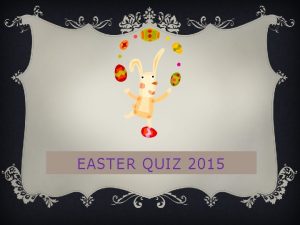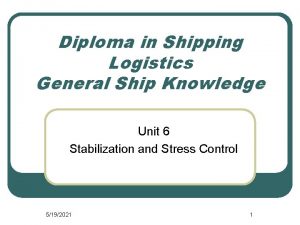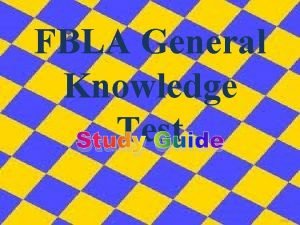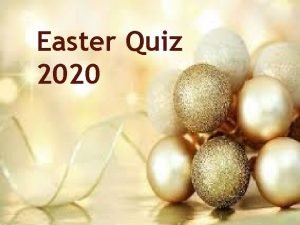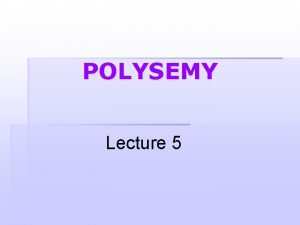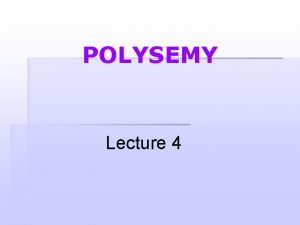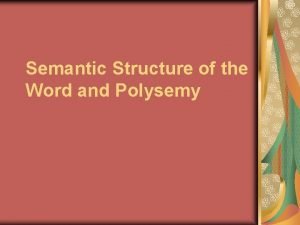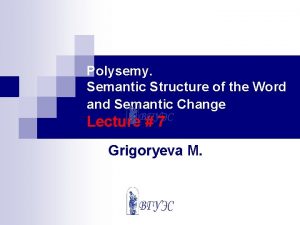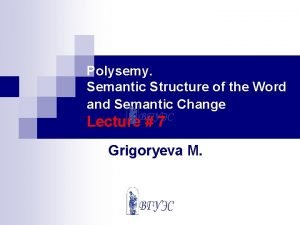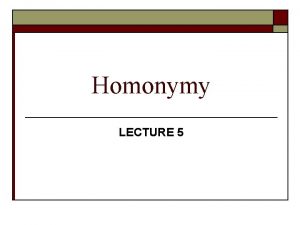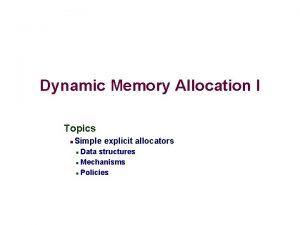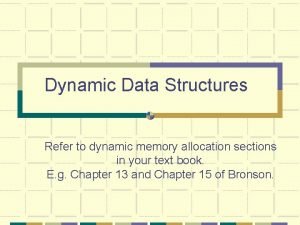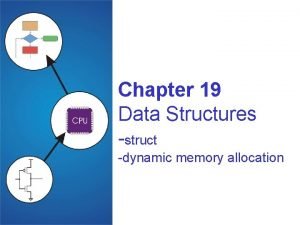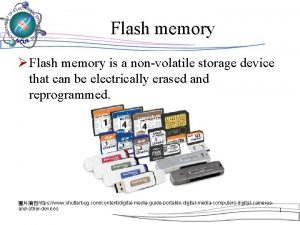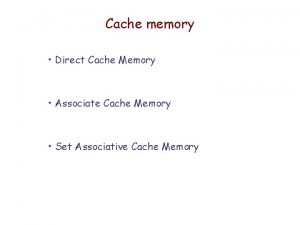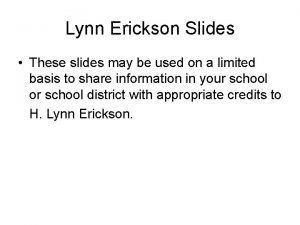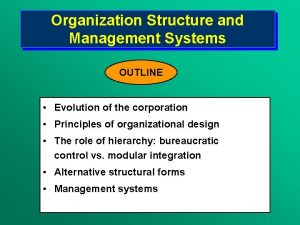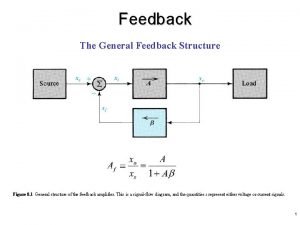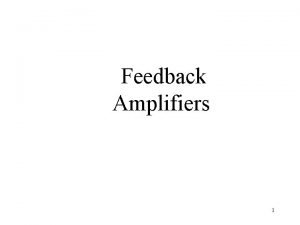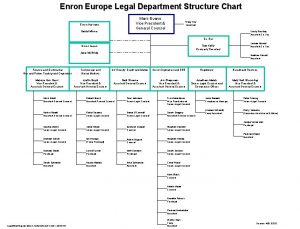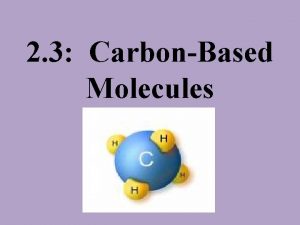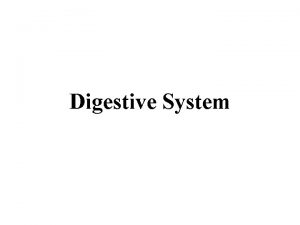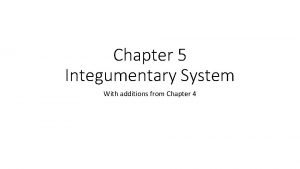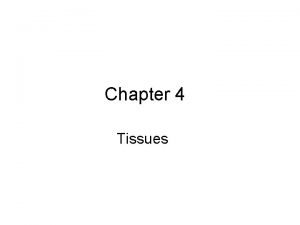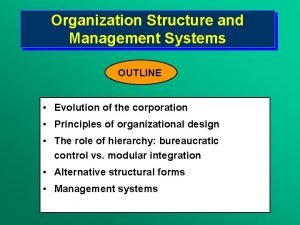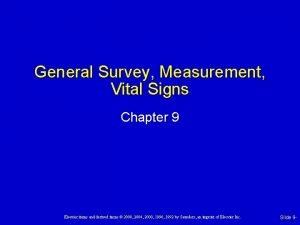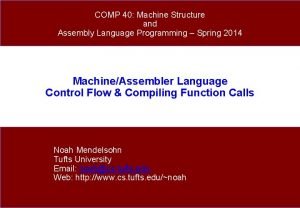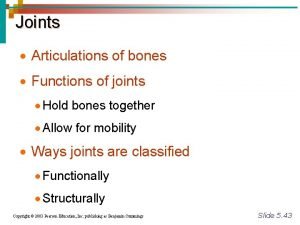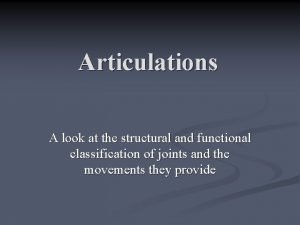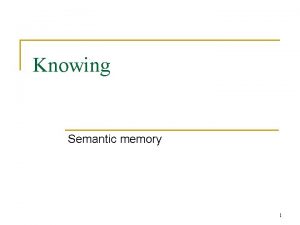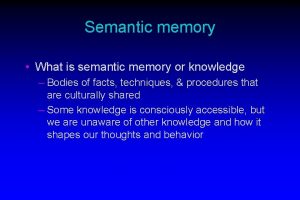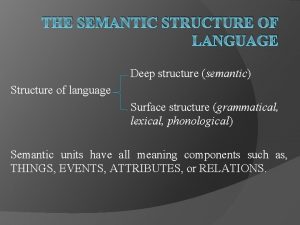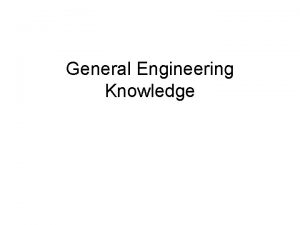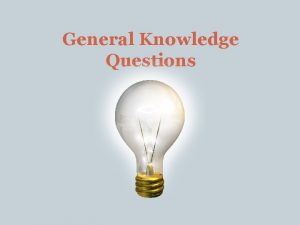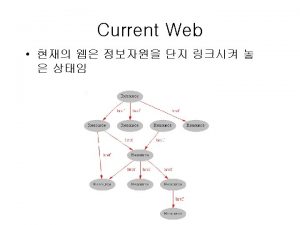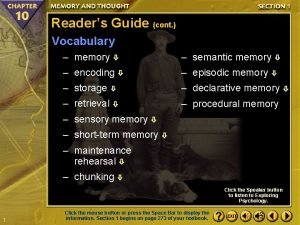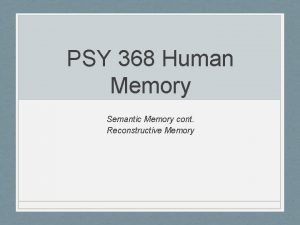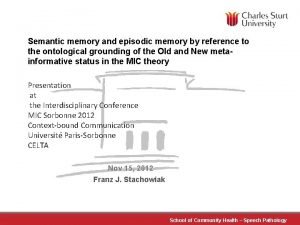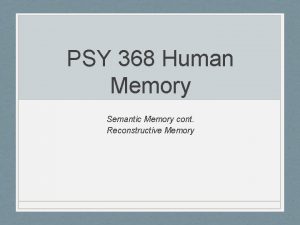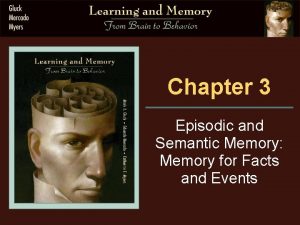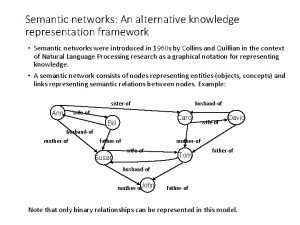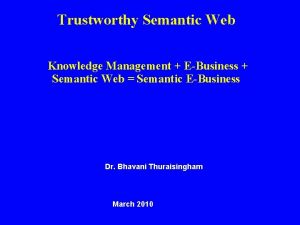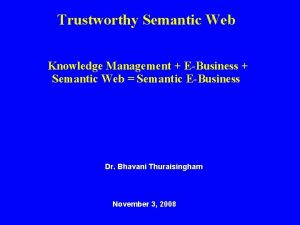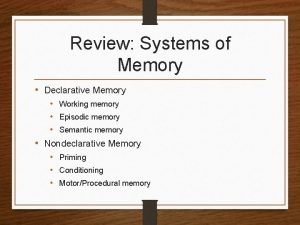Semantic Memory 1 General Knowledge Structure of Semantic





























































- Slides: 61

Semantic Memory 1

General Knowledge • Structure of Semantic Memory • Background • Feature Comparison Model • Prototype Approach • Exemplar Approach • Network Models • Schemas & Scripts • Background • Recall of Scripts • Schemas & Memory Selection • Schemas & Boundary Extension • Schemas & Memory Abstraction • Schemas & Memory Inferences • Schemas & Integration in Memory • Conclusions 2

Semantic Memory • General Conceptual Knowledge • Lexical Knowledge (e. g. , “apple” and ) • Organized - (e. g. , ‘pencil’ related to ‘pen’; think of ‘apple’ ----> ‘banana’ • Categories and Concepts Category - a class of objects that belong together (e. g. , variety of objects: ‘fruits’ or ‘apple’) Concept - mental representation of a category 3

• Concepts allow us to make inferences when we encounter new instances (e. g. read ‘chair) • Natural concepts vs. Artifacts • Questions • Organization and Structure? • Storage? • Inferences? • Cognitive Economy? • Relatedness and Similarity? 4

The Sentence Verification Technique For each of the items below, answer as quickly as possible either true or false. 1. 2. 3. 4. 5. 6. 7. 8. A poodle is a dog. A squirrel is an animal. A flower is a rock. A carrot is a vegetable. A mango is a fruit. A petunia is a tree. A robin is a bird. A rutabaga is a vegetable. 5

Classic Feature Comparison Models • Concepts = list of features or attributes (e. g. , Smith, Shoben, and Rips 1974) • Classic Definition of Concepts • Defining vs. Characteristic Features • Decision Process - 2 Stages • Stage 1 = compare all features (global comparison) • Stage 2 = compare only the defining features • Typicality Effects 6

The Sentence Verification Technique How does the Feature Comparison Model account for differences in response times? 1. 2. 3. 4. 5. 6. 7. 8. A poodle is a dog. A squirrel is an animal. A flower is a rock. A carrot is a vegetable. A mango is a fruit. A petunia is a tree. A robin is a bird. A rutabaga is a vegetable. 7

chicken abird AArobin bulldozer batisisaisais AA robin abird 8

The Prototype Approach 9

Prototype Approach • Classical View vs. Protoype • Eleanor Rosch • Category organized around a Prototype – An ideal member • Membership established by comparing possible members to the prototype • Graded membership – members vary in how representative of the category they are 10

What is a bachelor? • According to the classic definition of conceptual representation of category membership: • bachelor = unmarried, male. • But which of these individuals is really a bachelor? • My 6 month old son Tim • An elderly Catholic Priest • My 32 -year old cousin, John, who works at a bank in Chicago 11

Characteristics of Prototypes 1. Prototypes are supplied as examples of a category. 2. Prototypes serve as reference points. 3. Prototypes are judged more quickly after priming. 4. Prototypes can substitute for a category name in a sentence. 5. Prototypes share common attributes in a family resemblance category. • No one attribute shared by all members • In / out phenomenon 12

Prototypes Supplied as Examples of a Category – (e. g. Mervis, Catlin, & Rosch (1976)) • Group 1: generated examples for 8 different categories • • Birds? … robin, sparrow … Fruits? Sports? Etc. • Group 2: provided prototype ratings (low to high) for each example e. g. , sparrow 7 - high penguin 2 - low • Strong correlation between frequency and rating • Typicality Effect 13

Prototypes serve as Reference Points 14

Prototypes Judged More Quickly than Nonprototypes, After Semantic Priming 15

For the following items: Decide whether each item is a word (‘yes’) or not a word (‘no’). Respond by pressing the ‘yes’ button or the ‘no’ button: apple table tadjld mountain pudor 16

Lexical Decision Task You must decide whether each item is a word (‘yes’) or not a word (‘no’). The DV is the response time & the IV is the type of stimulus (e. g. word vs. nonword) apple table tadjld mountain pudor 17

What Is a Priming Effect? Lexical Decision Task doctor Y/N hospital automobile doctor Y/N 400 ms 450 ms 18

Category Priming Effect Prime: RTs? : Robin Penguin 550 ms. 670 ms. Bird Robin Penguin ? ms. 480 ms. ? ms. 660 ms. 19

Prototypes can substitute for a Category Name 20

Prototypes Share Attributes in a Family Resemblance Category 21

22

Group 1: Prototype Ratings e. g. , vehicles: car, truck, tractor, sled vegetable: carrots, beets, eggplant clothing: shirt, sweater, vest Group 2: List attributes possessed by each item: e. g. , car: wheels, steering wheel, doors, etc. Score: What proportion of an item’s attributes were shared by other category member’s Strong correlation between score and prototype rating. 23

Levels of Categorization 24

What are these objects? 25

Levels of Categorization 1 • Superordinate Level • furniture, animal, tool • Basic Level • chair, dog, screwdriver • Subordinate Level • desk chair, German Shepherd, flathead screwdriver 26

Characteristics of the Basic Level 1. Basic-level names are used to identify objects 2. Members of basic-level categories have more attributes in common 3. Experts use subordinate categories differently 27

Experts vs. Novices 28

Conclusions about Prototype Approach • Prototype approach accounts for our ability to form concepts about groups or categories that are loosely structured • Prototypes are idealizations or abstractions from many examples of a category • What constitutes a prototype for a given category can shift over time (e. g. a prototypical piece of clothing) • What about specific information about a particular member? Need another mechanism perhaps. 29

Exemplar Approach 30

Exemplar Approach • First learn information about specific examples of a category. • Each example stored in memory is called an exemplar • The conceptual representation of a category is simply the collection of stored exemplars for that category • Decision Process = Potential ‘new’ member compared to the collection of exemplars. • We classify new stimulus by deciding how closely it resembles all of the stored examples of a category. 31

Conclusions about the Exemplar Approach • Exemplar approach emphasizes there is no need for abstraction. • Abstraction (or forming a prototype) requires throwing away specific information about individual cases • Problem with the exemplar approach: Semantic memory storage requirements may be enormous • May be more suitable for smaller categories 32

Comparing Prototype & Exemplar Approaches • Both approaches suggest category membership is determined by comparing a new item against a stored representation of the category. • If the similarity of new item is strong enough, you conclude the item belongs in the category. • Prototype approach – Stored representation is a summary (or abstraction), an idealized, best member • Exemplar approach – Stored representation is the collection of stored exemplars (or examples) of the category. 33

Stored Representation Prototype Approach Typical or idealized representation Exemplar Approach Stored representation = Specific members / instances 34

In the Prototype Approach the conceptual representation of the category is a prototype or summary representation of all members of that category. 35

In the Exemplar Approach the conceptual representation of the category is the collection of stored exemplars for that category. 36

Combining Both Approaches • Exemplar approach may be most relevant when a category is small. • Prototypes may be more relevant as category size increases • Individual differences (e. g. as a function of expertise) • Possible co-existence of prototypes and exemplars • Strategic differences • Importance of category learning 37

Network Models 38

Network Models • Semantic networks • (concepts and connections ----> nodes and links) • Collins & Loftus • Node = concept Link = relation or connection • Spreading activation • Sentence verification ----> intersections • Explaining ‘Typicality Effect’ 39

40

41

Activation Spread Does a robin breathe? 42

Activation Spread Does a robin breathe? 43

44

45

Summary of Network Models Unlike the other theories, Network Models capture relationships between concepts Network Models capture the hierarchical nature of Categorical Knowledge. Network Models can easily explain typicality effects 46

Schemas & Scripts 47

Schemas 1. Larger cognitive units 2. Packages of interrelated units 3. Used to interpret, encode, understand, and remember new instances 4. Provide expectations about what should occur (top - down) 5. Default values / parts - filled in when schema activated 6. Sometimes - errors 48

Scripts • Simple, well- structured sequence of events associated with a highly familiar activity • Schema vs. script • Recall of scripts • Different from conceptual categories (Barsalow & Sewell, 1985) • Script Identification - early vs. late (Trafimow and Wyer, 1993) 49

Trafimow & Wyer (1993) • 4 different scripts • • Photocopying a piece of paper Cashing a check Making tea Taking the subway • Irrelevant details added (e. g. , taking candy out of pocket) • Script - identification information presented first or last • Filler • Recall: of script - related events 23% vs. 10% (script identified first) (script identified last) 50

51

Demonstration 52

53

Okay… Write down everything that you can remember seeing in the room. I’ll give you 1 minute Starting now. … 10 … 20 … 30 … 40 … 50 … 60 54

55

Schemas and Memory Selection • Remember best info consistent with schema or inconsistent • Brewer & Treyons (1981) • Rojahn & Pettigrew (1992) • Incidental vs. Intentional learning 56

Schemas and Memory Abstraction • Abstraction Process • Verbatim vs. Gist 57

58

59

Results? How many of the sentences did you recognize as ‘old’ sentences? Most participants recognize half or more of the sentences as old. In fact, none of the sentences were from the original list (old). They were all new sentences Why do these new sentences feel old? We’ve formed a general representation of the scene…the beginnings of a schema. 60

Schemas and Inferences in Memory • Bartlett (1932) • Ebbinghaus vs. Bartlett • Interaction of prior knowledge and experience and formation of new memories • “War of the Ghosts” story • Initial vs. Delayed Recall 61
 Semantics prototype
Semantics prototype Semantic memory
Semantic memory The study of meanings
The study of meanings Implicit memory
Implicit memory Long term memory vs short term memory
Long term memory vs short term memory Internal memory and external memory
Internal memory and external memory Primary memory and secondary memory
Primary memory and secondary memory Memory swaping
Memory swaping Which memory is the actual working memory?
Which memory is the actual working memory? Virtual memory
Virtual memory Virtual memory in memory hierarchy consists of
Virtual memory in memory hierarchy consists of Eidetic memory vs iconic memory
Eidetic memory vs iconic memory Shared vs distributed memory
Shared vs distributed memory Shared knowledge vs personal knowledge
Shared knowledge vs personal knowledge Knowledge shared is knowledge squared
Knowledge shared is knowledge squared Knowledge shared is knowledge multiplied interpretation
Knowledge shared is knowledge multiplied interpretation Knowledge creation and knowledge architecture
Knowledge creation and knowledge architecture Contoh shallow knowledge dan deep knowledge
Contoh shallow knowledge dan deep knowledge Example of posteriori knowledge
Example of posteriori knowledge Book smart vs street smart
Book smart vs street smart Shared knowledge vs personal knowledge
Shared knowledge vs personal knowledge Gertler econ
Gertler econ General knowledge quiz 2015
General knowledge quiz 2015 Jeopardy general knowledge
Jeopardy general knowledge General knowledge quiz 2016
General knowledge quiz 2016 General knowledge quiz 2015
General knowledge quiz 2015 General ship knowledge
General ship knowledge Usa general knowledge
Usa general knowledge What is fbla-pbl’s official parliamentary authority?
What is fbla-pbl’s official parliamentary authority? Easter quiz 2020
Easter quiz 2020 Planos en cinematografia
Planos en cinematografia Where did general lee surrender to general grant?
Where did general lee surrender to general grant? Historical changeability of semantic structure
Historical changeability of semantic structure Historical changeability of semantic structure
Historical changeability of semantic structure Synchronic and diachronic approaches to polysemy
Synchronic and diachronic approaches to polysemy Semantic changes
Semantic changes Semantic structure of words
Semantic structure of words Examples of polysemy
Examples of polysemy Dynamic memory allocation in data structure
Dynamic memory allocation in data structure Dynamic data structure
Dynamic data structure Dynamic memory allocation in data structure
Dynamic memory allocation in data structure Nonvolatile storage
Nonvolatile storage Cache memory structure
Cache memory structure Lynn erickson structure of knowledge
Lynn erickson structure of knowledge General motors hierarchy
General motors hierarchy Structure of feedback
Structure of feedback General
General Gain desensitivity
Gain desensitivity General feedback structure
General feedback structure Legal department organizational chart
Legal department organizational chart Protein general structure
Protein general structure General structure of digestive tract
General structure of digestive tract Papillary and reticular layers
Papillary and reticular layers General structure of exocrine glands
General structure of exocrine glands General motors organizational structure
General motors organizational structure Chaernobyl
Chaernobyl General
General General machine structure in system programming
General machine structure in system programming Amphiarthrosis examples
Amphiarthrosis examples General structure of a synovial joint
General structure of a synovial joint Barbiturates general structure
Barbiturates general structure Covalent bond boiling point
Covalent bond boiling point

